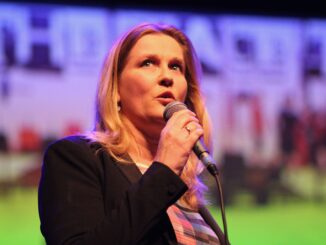
IBM Director en HR leader Katherine Faichnie: By improving its employee experience, IBM Canada knows that employees are more likely to not only work with the company, but stay and help it grow – and ultimately, provide better service to clients. Post van Eric Wood op itbusiness.ca, augustus 2016.
IBM’s HR leaders on how a culture of innovation can boost employee engagement
Innovation is built into IBM Corp.’s DNA, and that extends to its HR practices, its HR leaders say. It’s no accident that, in addition to running one of the largest research and development divisions in the world and being the top U.S. patent recipient for 23 consecutive years, the Armonk, New York-based tech giant has been declared one of Canada’s most desirable employers by international HR services provider Randstad Holding nv for two years in a row.
“At IBM… we have a heavy focus on innovation – innovation in our products and solutions that we give over to our clients, but also innovation that we hope, and that we know, impacts the world,” Katherine Faichnie, IBM Canada’s director and HR leader, tells ITBusiness.ca.
By improving its employee experience, IBM Canada knows that employees are more likely to not only work with the company, but stay and help it grow – and ultimately, provide better service to clients, Faichnie says.
“Surveys and statistics show that employees that are proud of the company they work for deliver better customer service,” she notes.
And just like its products and solutions, the company applies its ethos of innovation to multiple facets of HR, Faichnie says.
Innovating performance management
Unlike the company’s dedication to research and patent applications, IBM’s current performance management strategy isn’t even a year old – but like many of its newest technological breakthroughs, it was driven by big data, Carrie Altieri, IBM’s vice-president of communications for HR, says.
“There’s almost no area of HR at IBM that hasn’t been reinvented because of data,” she says. “There are hundreds of data scientists within IBM that are looking at HR… and the surprising reality is that the one skill expected more from HR people than ever before is analytics capabilities.”
Much of the reason for IBM’s reliance on HR data lies, of course, with the sheer scale of its operations: the company has hired more than 100,000 new employees worldwide since January 2015, including 30,000 since January alone.
“If you look at our current portfolio, IBM is a very different business than when I started over 10 years ago,” Altieri says. “All of this analytics and cloud computing and helping clients design their web interface… that’s all work that we were not doing years ago, but we’re doing it now. So we need those skills.”
Coming from the wider tech world and accustomed to user-friendly consumer experiences, many of these new hires expect their work life to be much more personalized, she says – that they will be asked for their opinion and that the company will act on it, a feature that was absent from IBM’s former annual performance review system, known as Personal Business Commitments.
“That system, which we had in place for more than a decade, was no longer aligned with how IBM-ers were working,” Altieri says. “It wasn’t even aligned to how work gets done anymore.”
And so, rather than convening a group of HR managers to design a new performance management system, the company’s HR department shifted its focus to soliciting ideas from employees, using Connections, IBM’s internal social media platform, to run roundtables and encourage feedback.
The company’s initial blog post asking employees to share their ideas for a new performance management system received more than 200,000 views alone, and staff collected nearly 100,000 comments from the project’s various blogs and physical roundtables.
“We wanted an online debate,” Altieri says. “Like, ‘You’re not really going to make any changes… You have the whole thing worked out, and this is all for theatre. You’re going to come out in two weeks and tell us your plan.’ We received comments like that.”
Using social listening technologies, the company also determined which demographics weren’t fully participating in the project – and made a point of including them in the roundtables.
[…]
Voor de rest van het artikel: klik hier



